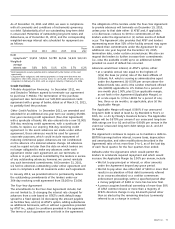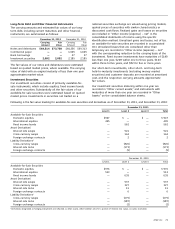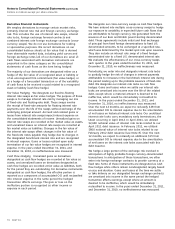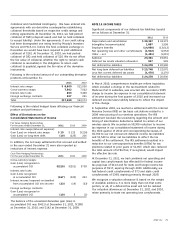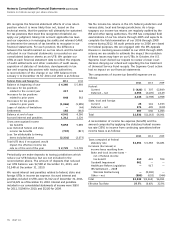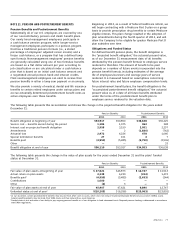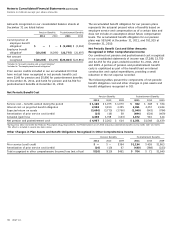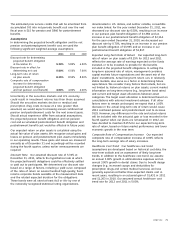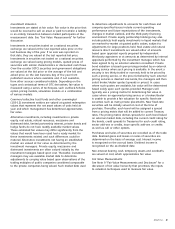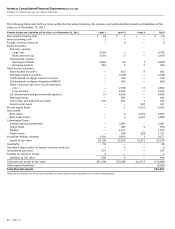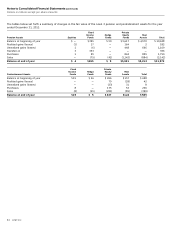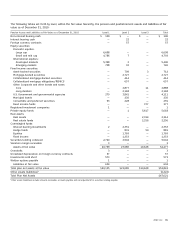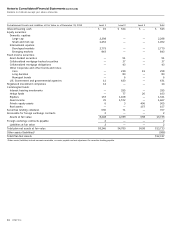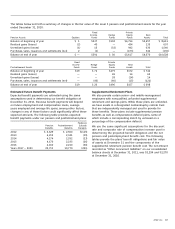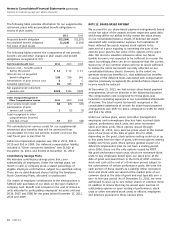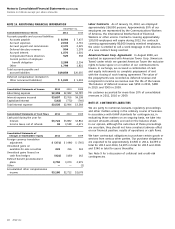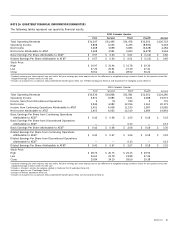AT&T Wireless 2011 Annual Report Download - page 83
Download and view the complete annual report
Please find page 83 of the 2011 AT&T Wireless annual report below. You can navigate through the pages in the report by either clicking on the pages listed below, or by using the keyword search tool below to find specific information within the annual report.
AT&T Inc. 81
Investment Valuation
Investments are stated at fair value. Fair value is the price that
would be received to sell an asset or paid to transfer a liability
in an orderly transaction between market participants at the
measurement date. See “Fair Value Measurements” for further
discussion.
Investments in securities traded on a national securities
exchange are valued at the last reported sales price on the
last business day of the year. If no sale was reported on
that date, they are valued at the last reported bid price.
Investments in securities not traded on a national securities
exchange are valued using pricing models, quoted prices of
securities with similar characteristics or discounted cash flows.
Over-the-counter (OTC) securities and government obligations
are valued at the bid price or the average of the bid and
asked price on the last business day of the year from
published sources where available and, if not available,
from other sources considered reliable. Depending on the
types and contractual terms of OTC derivatives, fair value is
measured using a series of techniques, such as Black-Scholes
option pricing models, simulation models or a combination
of various models.
Common/collective trust funds and other commingled
(103-12) investment entities are valued at quoted redemption
values that represent the net asset values of units held at
year end which management has determined approximates
fair value.
Alternative investments, including investments in private
equity, real estate, natural resources, mezzanine and
distressed debt, limited partnership interest, private bonds and
hedge funds do not have readily available market values.
These estimated fair values may differ significantly from the
values that would have been used had a ready market for
these investments existed, and such differences could be
material. Alternative investments not having an established
market are valued at fair value as determined by the
investment managers. Private equity, mezzanine and
distressed investments are often valued initially by the
investment managers based upon cost. Thereafter, investment
managers may use available market data to determine
adjustments to carrying value based upon observations of the
trading multiples of public companies considered comparable
to the private companies being valued. Such market data used
to determine adjustments to accounts for cash flows and
company-specified issues include current operating
performance and future expectations of the investments,
changes in market outlook, and the third-party financing
environment. Private equity partnership holdings may also
include publicly held equity investments in liquid markets that
are marked-to-market at quoted public values, subject to
adjustments for large positions held. Real estate and natural
resource direct investments are valued either at amounts
based upon appraisal reports prepared by independent
third-party appraisers or at amounts as determined by internal
appraisals performed by the investment manager, which has
been agreed to by an external valuation consultant. Private
bond valuation is based upon pricing provided by an external
pricing service when such pricing is available. In the event a
security is too thinly traded or narrowly held to be priced by
such a pricing service, or the price furnished by such external
pricing services is deemed inaccurate, the managers will then
solicit broker/dealer quotes (spreads or prices). In cases
where such quotes are available, fair value will be determined
based solely upon such quotes provided. Managers will
typically use a pricing matrix for determining fair value in
cases where an approved pricing service or a broker/dealer
is unable to provide a fair valuation for specific fixed-rate
securities such as many private placements. New fixed-rate
securities will be initially valued at cost at the time of
purchase. Thereafter, each bond will be assigned a spread
from a pricing matrix that will be added to current Treasury
rates. The pricing matrix derives spreads for each bond based
on external market data, including the current credit rating for
the bonds, credit spreads to Treasuries for each credit rating,
sector add-ons or credits, issue specific add-ons or credits
as well as call or other options.
Purchases and sales of securities are recorded as of the trade
date. Realized gains and losses on sales of securities are
determined on the basis of average cost. Interest income
is recognized on the accrual basis. Dividend income is
recognized on the ex-dividend date.
Non-interest bearing cash, temporary assets and overdrafts
are valued at cost, which approximates fair value.
Fair Value Measurements
See Note 9 “Fair Value Measurements and Disclosure” for a
discussion of fair value hierarchy that prioritizes the inputs
to valuation techniques used to measure fair value.


